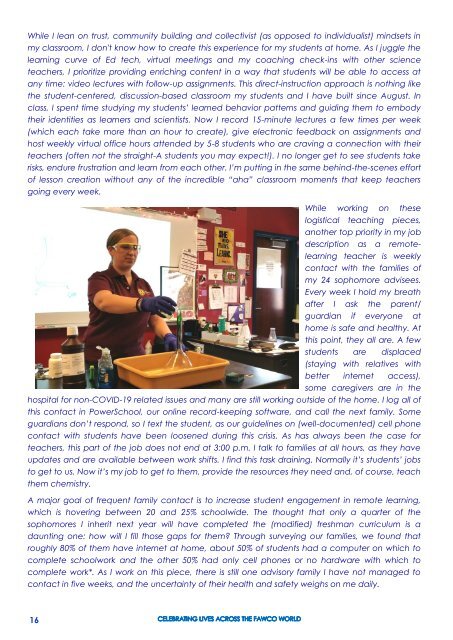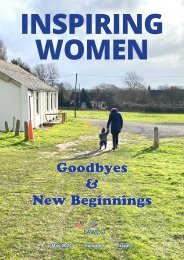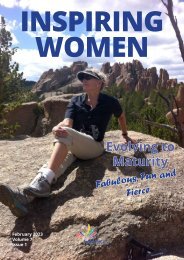Inspiring Women SUMMER 2020
You also want an ePaper? Increase the reach of your titles
YUMPU automatically turns print PDFs into web optimized ePapers that Google loves.
While I lean on trust, community building and collectivist (as opposed to individualist) mindsets in<br />
my classroom, I don't know how to create this experience for my students at home. As I juggle the<br />
learning curve of Ed tech, virtual meetings and my coaching check-ins with other science<br />
teachers, I prioritize providing enriching content in a way that students will be able to access at<br />
any time: video lectures with follow-up assignments. This direct-instruction approach is nothing like<br />
the student-centered, discussion-based classroom my students and I have built since August. In<br />
class, I spent time studying my students’ learned behavior patterns and guiding them to embody<br />
their identities as learners and scientists. Now I record 15-minute lectures a few times per week<br />
(which each take more than an hour to create), give electronic feedback on assignments and<br />
host weekly virtual office hours attended by 5-8 students who are craving a connection with their<br />
teachers (often not the straight-A students you may expect!). I no longer get to see students take<br />
risks, endure frustration and learn from each other. I’m putting in the same behind-the-scenes effort<br />
of lesson creation without any of the incredible “aha” classroom moments that keep teachers<br />
going every week.<br />
While working on these<br />
logistical teaching pieces,<br />
another top priority in my job<br />
description as a remotelearning<br />
teacher is weekly<br />
contact with the families of<br />
my 24 sophomore advisees.<br />
Every week I hold my breath<br />
after I ask the parent/<br />
guardian if everyone at<br />
home is safe and healthy. At<br />
this point, they all are. A few<br />
students are displaced<br />
(staying with relatives with<br />
better internet access),<br />
some caregivers are in the<br />
hospital for non-COVID-19 related issues and many are still working outside of the home. I log all of<br />
this contact in PowerSchool, our online record-keeping software, and call the next family. Some<br />
guardians don’t respond, so I text the student, as our guidelines on (well-documented) cell phone<br />
contact with students have been loosened during this crisis. As has always been the case for<br />
teachers, this part of the job does not end at 3:00 p.m. I talk to families at all hours, as they have<br />
updates and are available between work shifts. I find this task draining. Normally it’s students’ jobs<br />
to get to us. Now it’s my job to get to them, provide the resources they need and, of course, teach<br />
them chemistry.<br />
A major goal of frequent family contact is to increase student engagement in remote learning,<br />
which is hovering between 20 and 25% schoolwide. The thought that only a quarter of the<br />
sophomores I inherit next year will have completed the (modified) freshman curriculum is a<br />
daunting one: how will I fill those gaps for them? Through surveying our families, we found that<br />
roughly 80% of them have internet at home, about 50% of students had a computer on which to<br />
complete schoolwork and the other 50% had only cell phones or no hardware with which to<br />
complete work*. As I work on this piece, there is still one advisory family I have not managed to<br />
contact in five weeks, and the uncertainty of their health and safety weighs on me daily.<br />
16

















